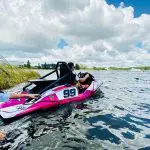For most owners the initial purchase or entry into the waters of personal watercraft is prompted by the desire for sheer relaxation and recreation: Leisurely touring rides are oft the only agenda.
But for those with a penchant for competition, or more sporting pursuits, errant thoughts of racing can begin to creep in.
Racing your personal watercraft is some of the most fun you could possibly have, but competition at a high level is also a crucible of heat and pressure.
For those who’ve never raced, it’s likely best to dip a toe in the water before jumping all the way in.
Whether you’re a young gun of a newcomer, or someone with a few more miles on the odometer, the correct steps along the way are the same.
Contents
Testing the waters
In the initial halcyon early days of runabouts, when user-friendly sit-down personal watercraft first supplanted the more difficult to ride stand-up skis from the top of the marketplace, waterways across the country fairly exploded with new riders.
And not unlike the stories of the first time two automobiles occupied the same space, races naturally ensued.
After a time, however, straight line drag races across the race lose their luster. Once a few friends establish a pecking order of who has the fastest boat, the results either won’t change… or will become a race of another kind: Who can spend the most money buying aftermarket parts and modifying their craft to be still quicker.
And so it remains today. Two-strokes have become four, and the weight of your average runabout has doubled along with its stability, amenities, and creature comforts abound. And still, impromptu head-to-head speed runs invariably pop up whenever two PWC riders find themselves in the same waters.
But what if we change the game?
Let’s race
One boat is always faster than another. Even two ostensibly identical models will have subtle differences in performance. As to the pilot, whoever is lighter on the scales usually has an advantage over a larger rider in a straight-line race.
Time to jump online and see how much money we can spend for go-fast parts?
There is another alternative. One where skill and strategy can outweigh top speed or a heavy wallet.
Buy some buoys
No one starts off as a well-rounded baseball player. You have to walk before you can run, and playing catch in the front yard is a solid start before ever walking onto a ball diamond.
Likewise, showing up for an organized PWC race without first developing the necessary skills is pure folly.
Whether the aim is becoming a serious competitor or merely expanding the ways you can have fun on your runabout, I highly recommend purchasing six to eight yellow buoys and an equal number of orange ones (or any two contrasting colors) and setting up an impromptu course for you and your friends.

You’ll need to have a body of water where such antics are allowed, of course, but if you have access to a lake sans speed limits there is usually a cove eschewed by water-skiers and fishermen that can be claimed for a few hours of turn and burn fun.
Set up a course
Most public bodies of water prohibit establishing any sort of permanent buoys or markers, but unless your area is particularly restrictive a temporary course will be allowable.
You may want to check with local law enforcement, or you can opt for asking for forgiveness instead of permission.
Use empty detergent bottles or the like filled with sand as anchors, and tie your buoys off with a quarter-inch rope at an appropriate length. This allows a course to be laid out within a matter of a few minutes and easy removal at the end of your day.
Designate one of your two colors as the right-hand turns. The other of course will be left-hand corners. Any variation of a mix of sweeping and tighter turns will work, and experimentation with layouts will lead to good course design. If a particular part of your initial “track” layout doesn’t work, simply drag the buoy in question to another location.
Safety first
Those who rush headlong into head-to-head competition on a buoy course are likely doomed to play bumper boats. Nothing puts an end to an afternoon of fun like a hole being punched in one PWC hull by another – or worse, if someone’s leg gets in the way.
Consider yourself urged to begin developing the proper skills with solo runs. If you must add an element of beating your buddies, use a stopwatch.
Eventually, as control and confidence rise, you might slowly introduce one-on-one competition and eventually more. Certainly, the pursuit becomes all the more entertaining when several jet skis are churning the water, but it also becomes much more dangerous.
Related: Jet Ski Safety Guidelines for Beginners
Clean lines
The most common cause of collisions in either impromptu closed course PWC competition or the real thing is when one rider follows another too closely. Never follow directly behind another rider.
Also, never attempt to initiate a pass on the inside of a corner. If you’re coming up the inside and the rider ahead of you spins, the impact is imminent. Always set up to the outside, and only cut back after the leader has completed the apex of his corner.
If you insist on the racing head to head, wear a helmet. Better by far to have riders start at opposite sides of the course: With one rider situated roughly 180 degrees from the other, it can be established who is quicker by who catches who. Does Actual overtake? Not recommended at a recreational level.
Start with what you have
In this day and age of comfort oriented watercraft, certain models still standout as more aggressive in design. Boats like Yamaha’s GP1800R, Sea-Doo’s RXP-X 300, and Kawasaki’s Ultra 310R all boast a deep heritage in racing but are by no means required to get started.
At the other end of the spectrum, a few friends all owning the affordable Sea-Doo Spark will likely have just as much fun competing with one another as they would on more powerful machines. (Maybe even more fun, as bouncing through the chop on a lightweight craft at lower speeds is often more challenging than it is with a 900-pound deep V-hull that rides deeper in the water.)
Running from buoy to buoy is more about acceleration and maneuverability than it is top speed. Yes, you determine that with the course layout, and a circuit without long straightaways will be both more challenging and safer. Set your course to emphasize the importance of changing direction and you’ll level the playing field for a wide variety of machines.
Even the most humble of machines available will accelerate to 30 mph in less than four seconds. That’s quick enough to be plenty entertaining.
To begin discovering the joys and benefits of a closed course, the jet ski you already own will easily suffice. Should you have a group of friends with boats that run the gamut of performance, you’ll still find that the rider’s skill will make more difference than the craft they ride.
Of course, as the hook takes a set, you may find yourself eyeballing a more race oriented ride in the future.
Technique
Setting up a buoy course will have most riders quickly discover that while they think they know how to turn a PWC, they likely really don’t. For many riders, skills that could pay off in any number of circumstances can rise rapidly and even exponentially with the addition of fixed points for corners.
You’ll learn to anticipate turns, and how to initiate corner entry before and not after the buoy. Turn in early and you’ll continue on the course rather than drifting wide. Conversely, turn in too early and you might bump the buoy or pass on the wrong side.
You’ll also find that even running solo, the smoothest waters will soon enough turn to roll or even sharp chop after repeated passes. More so if more than one rider is on the course. At that point, it’s no longer a sit and shoot proposition. You’ll want to stand up in the straightaways, and even in some corners.
You’ll be forced to learn the nuances of throttle control and weighting and unweighting the craft with your legs. You can literally dance with the waves for the best effect. Soak the hull up when bouncing above the water by bending at the knees, then extend to force the craft back down into the water. Let off the throttle if the pump is cavitating, or spinning the impeller without being immersed in the water.
Experiment with standing up through turns, and applying weight transfer to the outside of the hull. In right-hand corners, push down hard with your left leg. In left-handers, push with your right.
It’s so fun. And your skills will be enhanced in a way that will make you an all-around better and safer rider in any circumstance.
Physical effort
While recreational riding on a sitdown craft can be scarcely more physical than watching Netflix from your couch, closed-course riding with any sort of effort will become an athletic endeavor – and for some of us, the best kind of “gym” work takes place anywhere but indoors.
Riding a course is certainly exercise, but it’s disguised in so much fun you might not realize it – at least until the next day, when muscles you otherwise don’t use will be very sore. Don’t overdo it at first. But don’t overlook how much your physical (and mental) conditioning might be enhanced.
Six benefits
- Taking an athletic approach to riding your jet ski will get your heart beating. Blood circulation will improve, bringing more oxygen and nutrients to your entire body.
- Athletic riding will definitely tone and bring strength to your arms and shoulders, legs, back, and core abdominal muscles. The crouching, standing, and weighting the hull properly are all extremely physical efforts. Again, don’t get carried away the first few times if you have to go to work the next day!
- As your skills develop, you’ll likely notice that your overall balance and hand-eye coordination is enhanced in everyday life.
- You might just lose a few pounds. Riding athletically absolutely burns calories.
- Riding a buoy course demands focus and concentration in order to do it well. You will likely find that mental acumen developed riding the buoys will enhance your awareness of water conditions and other boaters in all situations.
- Stress relief is a thing. These are trying times we live in, and there are myriad things to wonder and worry about in the course of the day to day life. All of these trials and tribulations will slip to the wayside while you bust around the buoys – and you’ll almost invariably find yourself in a better mood when the sun sets.
Formal competition
After considerable practice, play, and expanding and enhancing your skill level, you may wish to pursue the sport into real racing.
This is not a decision to be taken lightly. Riding handlebar to handlebar with a dozen other riders is a bang-up endeavor. Contact with other boats will prove inevitable. In addition to a high quality life-vest, helmets, goggles, gloves, and a wetsuit will be required.
Though participation in formal watercraft racing has faded a bit from what it once was, there are still many local promoters and affiliations that offer racing. Start with visiting the ISJBA (International Jet Sports Boating Association) website for an overview of how it works at the highest level, but Google will also be your friend in finding out whether there is a racing organization holding events near you.
Races exist in many forms with many organizations for riders of all skill levels, from beginner to pro, and often with age break classes for more veteran riders. There will also be stock and modified divisions.
If you do choose to race, show up at the site early. Unload, organize your gear and your pit area, and be sure to attend the rider’s meeting. There, they’ll go over the course, explain the practice order and structure, and you’ll be able to get any questions you may have answered.
For the most part, racers are great people. You’ll find them encouraging to a newcomer and happy to help. Don’t be afraid to ask.
Even when moving from impromptu recreational sport riding to formal racing, the fastest most powerful racing machine will not be a requirement initially. Take note of what your competition is riding. Ask around for opinions. If the hook is truly set, you may start to consider a watercraft aimed at a competition.
But: Don’t even consider racing until you’ve spent many hours practicing on your own and with friends who have trustworthy boat handling skills. Remember that watercraft racing is most definitely not easier than it looks.
But it sure is fun!






